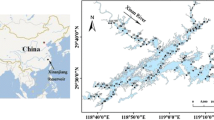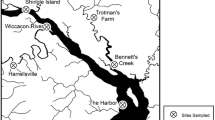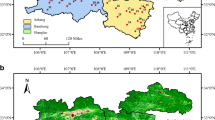Abstract
Chromophoric dissolved organic matter (CDOM) fluorescence or absorption is often proposed as a rapid alternative to chemical methods for the estimation of bulk dissolved organic carbon (DOC) concentration in natural waters. However, the robustness of this method across a wide range of systems remains to be shown. We measured CDOM fluorescence and DOC concentration in four tropical freshwater and coastal environments (estuary and coastal, tropical shallow lakes, water from the freshwater lens of two small islands, and soil leachates). We found that although this method can provide an estimation of DOC concentration in sites with low variability in DOC and CDOM sources in systems where the variability of DOC and CDOM sources are high, this method should not be used as it will lead to errors in the estimation of the bulk DOC concentration.



Similar content being viewed by others
References
Blough, N. V., & Del Vecchio, R. (2002). Chromophoric dissolved organic matter in the coastal environment. In D. Hansell & C. Carlson (Eds.), Biogeochemistry of marine dissolved organic matter (pp. 509–546). New York: Academic.
Comte, J. C., Banton, O., Join, J.-L., & Cabioch, G. (2010). Evaluation of effective groundwater recharge of freshwater lens in small islands by the combined modeling of geoelectrical data and water heads. Water Resources Research, 46, W06601. doi:10.1029/2009wr008058.
Del Giorgio, P. A., Cole, J. J., & Cimbleris, A. (1997). Respiration rates in bacteria exceed phytoplankton production in unproductive aquatic systems. Nature, 385(6612), 148–151.
Del Giorgio, P. A., & Davis, J. (2003). Patterns in dissolved organic matter lability and consumption across aquatic ecosystems. In S. Findlay & R. L. Sinsabaugh (Eds.), Aquatic ecosystems: interactivity of dissolved organic matter (pp. 399–424). Amsterdam: Academic.
Del Giorgio, P. A., & Duarte, C. M. (2002). Respiration in the open ocean. Nature, 420(6914), 379–384.
Downing, B. D., Bergamaschi, B. A., Evans, D. G., & Boss, E. (2008). Assessing contribution of DOC from sediments to a drinking-water reservoir using optical profiling. Lake and Reservoir Management, 24(4), 381–391. doi:10.1080/07438140809354848.
Downing, B. D., Boss, E., Bergamaschi, B. A., Fleck, J. A., Lionberger, N., Ganju, N., et al. (2009). Quantifying fluxes and characterizing compositional changes of dissolved organic matter in aquatic systems in situ using combined acoustic and optical measurements. Limnology and Oceanography: Methods, 7, 119–131. doi:10.4319/lom.2009.7.119.
Green, S. A., & Blough, N. V. (1994). Optical absorption and fluorescence properties of chromophoric dissolved organic matter in natural waters. Limnology and Oceanography, 39(8), 1903–1916.
Hedges, J. I. (1992). Global biogeochemical cycles : progress and problems. Marine Chemistry, 39, 67–93.
Hoge, F. E., Vodacek, A., & Blough, N. V. (1993). Inherent optical properties of the ocean—retrieval of the absorption coefficient of chromophoric dissolved organic matter from fluorescence measurements. Limnology and Oceanography, 38(7), 1394–1402.
Ishii, S. K. L., & Boyer, T. H. (2012). Behavior of reoccurring PARAFAC components in fluorescent dissolved organic matter in natural and engineered systems: a critical review. Environmental Science & Technology, 46(4), 2006–2017. doi:10.1021/es2043504.
Karlsson, J., Bystrom, P., Ask, J., Ask, P., Persson, L., & Jansson, M. (2009). Light limitation of nutrient-poor lake ecosystems. Nature, 460(7254), 506–509.
Kowalczuk, P., Zablocka, M., Sagan, S., & Kulinski, K. (2010). Fluorescence measured in situ as a proxy of CDOM absorption and DOC concentration in the Baltic Sea. Oceanologia, 52(3), 431–471.
Malcolm, R. L. (1990). The uniqueness of humic substances in each of soil, stream and marine environments. Analytica Chimica Acta, 232(1), 19–30.
Nelson, N. B., Siegel, D. A., & Michaels, A. F. (1998). Seasonal dynamics of colored dissolved material in the Sargasso Sea. Deep-Sea Research Part I-Oceanographic Research Papers, 45(6), 931–957.
Rochelle-Newall, E. J., Chu, V. T., Pringault, O., Amouroux, D., Arfi, R., Bettarel, Y., et al. (2011). Phytoplankton diversity and productivity in a highly turbid, tropical coastal system (Bach Dang Estuary, Vietnam). Marine Pollution Bulletin, 62, 2317–2329.
Rochelle-Newall, E. J., Delille, B., Frankignoulle, M., Gattuso, J.-P., Jacquet, S., Riebesell, U., et al. (2004). Chromophoric dissolved organic matter in experimental mesocosms maintained under different pCO2 levels. Marine Ecology-Progress Series, 272, 25–31.
Rochelle-Newall, E. J., & Fisher, T. R. (2002a). Chromophoric dissolved organic matter and dissolved organic carbon in Chesapeake Bay. Marine Chemistry, 77, 23–41.
Rochelle-Newall, E. J., & Fisher, T. R. (2002b). Production of chromophoric dissolved organic matter fluorescence in marine and estuarine environments: an investigation into the role of phytoplankton. Marine Chemistry, 77(1), 7–21.
Rochelle-Newall, E. J., Winter, C., Barron, C., Borges, A. V., Duarte, C. M., Elliott, M., et al. (2007). Artificial neural network analysis of factors controling ecosystem metabolism in coastal systems. Ecological Applications, 17(5), S185–S196.
Saraceno, J. F., Pellerin, B. A., Downing, B. D., Boss, E., Bachand, P. A. M., & Bergamaschi, B. A. (2009). High-frequency in situ optical measurements during a storm event: Assessing relationships between dissolved organic matter, sediment concentrations, and hydrologic processes. Journal of Geophysical Research: Biogeosciences, 114(G4), n/a-n/a, doi:10.1029/2009jg000989.
Sinsabaugh, R. L., & Findlay, S. E. G. (2003). Dissolved organic matter: out of the black box and into the mainstream. In S. E. G. Findlay & R. L. Sinsabaugh (Eds.), Aquatic ecosystems : interactivity of dissolved organic matter (pp. 479–498). Boston: Academic.
Stedmon, C. A., Markager, S., & Bro, R. (2003). Tracing dissolved organic matter in aquatic environments using a new approach to fluorescence spectroscopy. Marine Chemistry, 82(3–4), 239–254.
Steinberg, D. K., Nelson, N. B., Carlson, C. A., & Prusak, A. C. (2004). Production of chromophoric dissolved organic matter (CDOM) in the open ocean by zooplankton and the colonial cyanobacterium Trichodesmium spp. Marine Ecology-Progress Series, 267, 45–56.
Suksomjit, M., Nagao, S., Ichimi, K., Yamada, T., & Tada, K. (2009). Variation of dissolved organic matter and fluorescence characteristics before, during and after phytoplankton bloom. Journal of Oceanography, 65(6), 835–846. doi:10.1007/s10872-009-0069-x.
Williams, P. J. L. B. (1998). The balance of plankton respiration and photosynthesis in the open oceans. Nature, 394, 55–57.
Williamson, C. E., Morris, D. P., Pace, M. L., & Olson, A. G. (1999). Dissolved organic carbon and nutrients as regulators of lake ecosystems: resurrection of a more integrated paradigm. Limnology and Oceanography, 44(3), 795–803.
Yamashita, Y., Kloeppel, B. D., Knoepp, J., Zausen, G. L., & Jaffe, R. (2011). Effects of watershed history on dissolved organic matter characteristics in headwater streams. Ecosystems, 14(7), 1110–1122. doi:10.1007/s10021-011-9469-z.
Yamashita, Y., & Tanoue, E. (2004). In situ production of chromophoric dissolved organic matter in coastal environments. Geophysical Research Letters, 31(14), L14302. doi:10.1029/2004GL019734.
Acknowledgments
This work was financed by the French IRD, the UMR Bioemco, the French programs EC2CO–Haiphong, EC2CO-Compaqua and CNES/TOSCA-VITEL, the ANR Vulnerabilité-INTERFACE, and the ANR Biodiversité–BIOFUN. JP Torréton and X. Mari are thanked for the access to their fluorometer as are the PIs of the above programs and the researchers and technicians who participated in the sample collection. The MSc. research of AM formed part of this work.
Author information
Authors and Affiliations
Corresponding author
Rights and permissions
About this article
Cite this article
Rochelle-Newall, E., Hulot, F.D., Janeau, J.L. et al. CDOM fluorescence as a proxy of DOC concentration in natural waters: a comparison of four contrasting tropical systems. Environ Monit Assess 186, 589–596 (2014). https://doi.org/10.1007/s10661-013-3401-2
Received:
Accepted:
Published:
Issue Date:
DOI: https://doi.org/10.1007/s10661-013-3401-2




